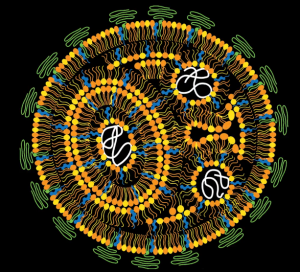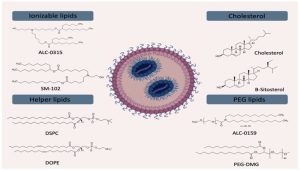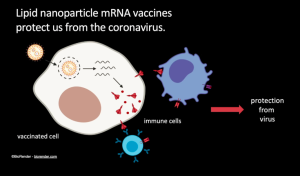56 Polymer Information
Brigitte Gallagher; Rachel Falkowski; and Jenna Diemel
Lipid nanoparticles with mRNA


Phospholipid bilayer (Yellow)
-
- Hydrophilic heads and hydrophobic tails, made up of helper lipids listed above.
- Acts to keep the nanoparticle organized meaning each section stays where it is supposed to be
- Acts as the membrane and allows the nanoparticle to pass into the cell
Cholesterol (Blue)
-
- Holds the phospholipids together because they are prone to separation by themselves
- Cholesterol is stiff, so it provides structure by inserting itself between the phospholipids to hinder movement.
Ionizable lipids (Orange)
-
- The heads of the lipids are ionizable, often due to tertiary amine or branched polyamines. These molecules are neutrally charged outside of the cell, but inside the cell they become positively charged. The positive charge inside the cell aids in mRNA delivery. Negatively charged mRNA is able to release into the cytosol of cells because the now positively charged ionizable lipid facilitates endocytosis.[1]
Polyethylene glycol (Green)
-
- Polyethylene glycol (PEG) acts as the final piece of glue in the lipid nanoparticle. PEG is hydrophilic and helps stabilize the molecules and decreases interaction between nanoparticles.[2][3]
mRNA (White)
-
- Messenger RNA (mRNA) is the genetic instructions telling a cell to make a protein. mRNA is being used to create antigens from viruses that the body recognizes as foreign to stimulate an immune response.[4]
Selection and Benefits

Lipid nanoparticles with mRNA were successfully utilized to create the COVID-19 vaccine due to their flexibility, speed and potency. The mRNA technology existed, but the key was finding a way to successfully get it into the cell. The use of the polymers listed above, through their unique jobs, allowed the technology to come to fruition, acting as a transportation vessel for mRNA. One advantage of this technology is that it utilizes the bodies natural protein making abilities to prevent or fight disease. Once it has shared those instructions, it is soon after eliminated from the body, never entering the cell nucleus and, therefore, does not interact with the user’s DNA. mRNA also does not require the actual virus to be created, only “instructions, or genetic code, to make a copy of the novel coronavirus’s spike protein”.[5]

